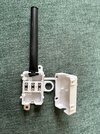- Joined
- 18 Nov 2003
- Messages
- 83
- Reaction score
- 3
- Country

I hate the cheapy plastic connector boxes which come supplied with metal ceiling and wall lamp fittings (pic attached). I would, before fitting, ideally like to replace the connectors with a wago 221's for ease of connecting. Probably being pedantic but I would prefer a lever type connection.
I have searched the forum and there seems to be a bit of confliction in advice given so I'd appreciate some advice on the following.
The lamps and wall lights are metal, double insulated.
If I were to remove the suppled plastic connector box and use wago 221's it would not be double insulated so I would need to connect an earth cable to the metal fitting; would this then be classed as safe considering that the wago connectors are only enclosed by the light fitting? Using a connector other than the lever type wouldn't be any use as the cables from the light fitting are stranded.
My other option is to use a wago box inside the wall or ceiling void which I'd rather not do if I can get away with it.
I've searched for a maintenance free container which would house the wagos and also fit into the lamp ceiling or wall housing but I don't seem to be able to find anything.
At the moment I'm leaning toward wago 221's and earth cable so any advice would be appreciated.
I have searched the forum and there seems to be a bit of confliction in advice given so I'd appreciate some advice on the following.
The lamps and wall lights are metal, double insulated.
If I were to remove the suppled plastic connector box and use wago 221's it would not be double insulated so I would need to connect an earth cable to the metal fitting; would this then be classed as safe considering that the wago connectors are only enclosed by the light fitting? Using a connector other than the lever type wouldn't be any use as the cables from the light fitting are stranded.
My other option is to use a wago box inside the wall or ceiling void which I'd rather not do if I can get away with it.
I've searched for a maintenance free container which would house the wagos and also fit into the lamp ceiling or wall housing but I don't seem to be able to find anything.
At the moment I'm leaning toward wago 221's and earth cable so any advice would be appreciated.


